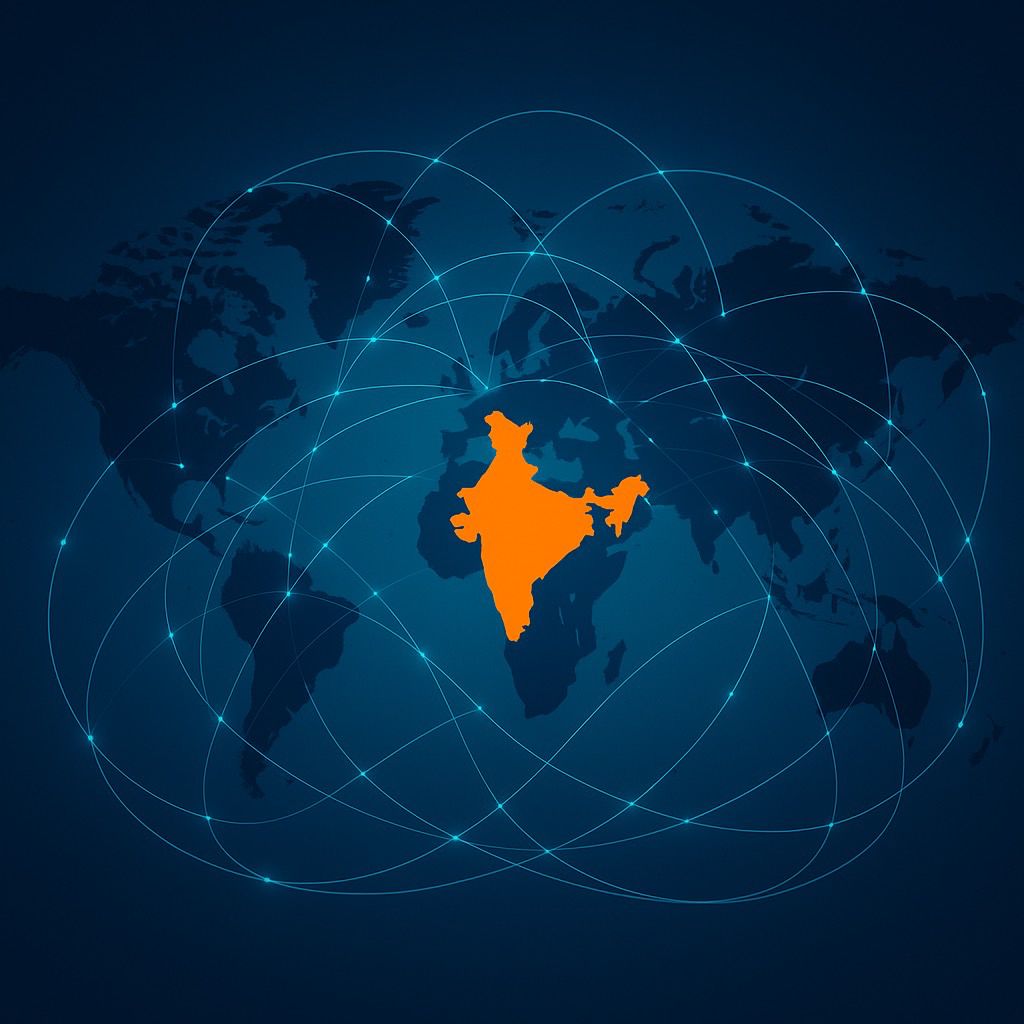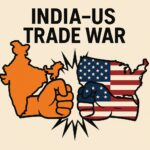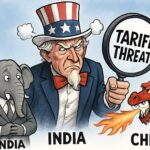When my Gen Z teenager advised me to stop overthinking a career decision and just “go do some ‘main character stuff,” I initially dismissed it as social media vernacular. But her philosophy—that sometimes you must claim center stage rather than wait to be invited—contains more strategic wisdom than most foreign policy doctrines. What she articulated, and what India has stumbled into, might be called “Gen Z geopolitics”: the recognition that in both the attention economy of TikTok and global politics alike, there is perhaps, no currency more valuable than controversy.
While nations spend decades crafting images of moral leadership and diplomatic virtue, India has stumbled upon—or perhaps strategically discovered—a more effective path to global prominence: strategic notoriety. Consider Oscar Wilde’s observation that “there is only one thing worse than being talked about, and that is not being talked about.” In the context of international relations, this paradox reveals something profound about the nature of power itself. Nations, like individuals, face a fundamental choice: they can be admired and ignored, or they can be controversial and, thereby, compelling.
President Trump’s decision to impose punitive 50 per cent tariffs on Indian goods—ostensibly to punish New Delhi for purchasing Russian oil—has achieved something decades of India’s soft power initiatives could not: it has made India impossible to ignore.
From Washington Post and New York Times editorials to Economist cover stories, to interviews on India on U.S. and international primetime news networks, to influencer podcasts and even late night politically-infused comedy shows, India has suddenly become the protagonist in a major geopolitical narrative like the Russia-Ukraine war, but more broadly in the rapid reshaping of the post-Trumpian world. The irony is delicious: in trying to marginalize India, Trump has inadvertently elevated it to global prominence.
But here’s what makes this moment historically significant: India finds itself in the rare position among major democracies of consciously embracing strategic notoriety by refusing to succumb to Trump’s tariff pressure. The transformation is so profound that it may not yet be fully understood even within India itself—a nation suddenly thrust into an uncomfortable “interstellar zone” between being a middle regional power and a more global consequential player.
Consider the economic anthropology of this shift. Markets, like geopolitical systems, reward predictability—until they don’t. In spite of escalating tariff pressure, India’s continued willingness to simultaneously purchase oil from Russia while deepening technological partnerships with America, to suddenly re-engage diplomatically with China (only months ago a no-go given China’s alleged support to Pakistan during earlier border tensions), while strengthening military ties with Japan, represents a masterclass in portfolio diversification applied to geopolitics.
The recent Shanghai Cooperation Organization summit provided a perfect case study in this new approach. The image of Xi Jinping, Vladimir Putin, and Narendra Modi—hands clasped, sharing what appeared to be genuine laughter—sent shockwaves through Western capitals. But Modi’s demeanor revealed something crucial—that this was not the nervous laughter of a leader caught between competing powers, but the confident smile of someone who was projecting that he held more cards than anyone had assumed.
Trump’s frustrated tweet days later confirmed the strategy’s success: “Looks like we’ve lost India and Russia to deepest, darkest, China. May they have a long and prosperous future together!” The language is telling—”deepest, darkest” suggests not just strategic convergence but something almost mystical, an “Axis of Autonomy” that refuses to be contained within Washington’s binary framework.
This represents a fundamental psychological shift that goes beyond traditional non-alignment. Classical Indian diplomacy, rooted in Nehruvian idealism, sought to position India as the world’s moral conscience—the largest democracy, the inheritor of Gandhi’s legacy, the voice of the developing world. Even Modi’s early international positioning embraced this “Vishwa Guru” (world teacher) identity, complete with his signature “hug diplomacy” that sought to charm world leaders into partnerships. It was a strategy designed to earn influence through inspiration, power through righteousness—an approach that sometimes, annoyed friends and foes alike, but was nevertheless tolerated and respected because of the perceived benign intent behind it.
But that patience ran out with Trump’s return. But as any game theorist will tell you, cooperative strategies become increasingly ineffective in multi-polar environments where defection is rewarded, and cooperation is exploited. In a world where multiple players compete simultaneously, those who consistently choose collaboration while others choose competition find themselves systematically disadvantaged—their predictable reasonableness becomes a strategic weakness that others exploit to advance their own interests.
Yet, the most fascinating aspect of this transformation may be its cultural dimensions. Indian civilization has always contained within it both the accommodating wisdom of the Vedas and the strategic ruthlessness of the Arthashastra—an ancient Indian treatise on statecraft written by Kautilya (also known as Chanakya) around 300 BCE. Often compared to Machiavelli’s “The Prince” but predating it by nearly two millennia, the Arthashastra advocates for pragmatic realpolitik, suggesting that a ruler should be prepared to use any means necessary to achieve state objectives.
For decades, India emphasized the former philosophical tradition while suppressing the latter. What we’re witnessing now might be described as the return of Kautilyan realpolitik, wrapped in the language of democratic values but animated by a harder understanding of how power actually works.
The parallels with other historical moments offer a learning moment. Lee Kuan Yew’s Singapore practiced what he called “pragmatic non-alignment,” maintaining relationships with all major powers while serving Singapore’s interests first. As he memorably declared in 2009, “We are a little red dot, but we are a special red dot. We are connected with the world; we play a special role. And we are not going to be in anybody’s pocket.”
Ironically, Modi’s first major engagement after returning from the Shanghai summit was with Singapore’s Prime Minister—perhaps a fitting choice given Singapore’s pioneering role in demonstrating how even small nations can maintain strategic autonomy. And by no means is India a small nation by any measure. More recently, Turkey under Erdogan has successfully played NATO membership against partnerships with Russia, extracting concessions from both sides. Both examples demonstrate that strategic autonomy sometimes requires strategic antagonism.
But India’s situation is more complex, and potentially more consequential, than these historical precedents. This moment represents both an internal Indian point of inflection and an external pivot for India in the comity of nations—the culmination of a long journey to this point in history, inadvertently arriving at a threshold it might not have been prepared to cross just yet. Suddenly, in the spotlight, the weight of civilizational heft, demographic depth, and economic imperative—the ambitious goal of lifting nearly 1.5 billion people into developed-nation status by India’s centennial in 2047—gives it no choice but to own the moment and cross into this treacherous interstellar zone inevitably filled with “treacherously unpredictable asteroids” and “fiery comets of competing interests and intersecting power plays.”
We are living in what might be called a neo-Nietzschean world, where Trump embodies the will to power through sheer dominance—the Übermensch who seeks to impose his reality on others through force of personality and economic coercion. In this context, Nietzsche’s insight that “he who wisheth one day to fly, must first learn standing and walking and running and climbing and dancing: —one doth not fly into flying!” seems particularly apt. India, through its policy tango of strategic autonomy, has thus far been learning to dance with multiple partners simultaneously, but Trump’s aggressive tactics have now thrust it toward a more independent flight path. And India might just be ready for flight.
The Finnish President Alexander Stubb’s recent warning that “we cannot afford to lose the Global South, especially India” reveals how completely the strategic calculus has shifted. Western leaders are beginning to recognize what India has apparently understood: in a world where everyone wants to be a rule-maker, sometimes you have to break a few rules to earn a seat at the table.
For this is where the philosophical rubber meets the geopolitical road. Strategic notoriety is a high-risk, high-reward approach that requires exceptional execution. It’s not enough to be controversial; you must be controversially effective. The limits of India’s strategic autonomy will be tested by how skillfully it navigates this new situation while maintaining the value of relationships and partnerships it has worked hard to build in the post-Cold War era.
India has taken some initial steps to buffer economic impacts—rationalizing its tax structure through GST reforms to absorb tariff shocks. But what external calibrations will it make beyond the high-voltage smiles and handshakes at Tianjin? Delhi is keeping Trump guessing for now, and his frustrated tweets demonstrate that Delhi’s initial moves have been unexpected and are hitting a nerve.
The world—and indeed all of India—is watching this experiment with fascination, like viewers binge-watching a geopolitical thriller where the protagonist has just revealed unexpected depths. Indians themselves seem surprised by this sudden notoriety, unaccustomed to seeing their nation cast in such a provocative role. The question isn’t whether India can employ tools of strategic ambiguity—democracies have done this before—but whether it can maintain its strategic “political geo-space” as US officials increasingly revive “with us or against us” postures not seen since the Bush era.
History suggests that middle powers often emerge precisely through such moments of strategic clarity disguised as strategic chaos. Consider how South Korea transformed from American protectorate to independent regional power by playing China against the US in the 1990s, or how Brazil leveraged its position between Washington and Beijing during the commodity boom. But execution will be everything.
India has long preferred to work the backrooms rather than the megaphones, quietly shaping agendas and opinions behind the scenes. Once, whether pejoratively or admiringly, India was called the “back office” powering the world’s business operations. But circumstances are now pushing it to lead from the front. The cultural DNA may drive India to hesitate—preferring consensus to confrontation, accommodation to assertion. But Trump is acting like an old-school domineering corporate CEO, extracting concessions through sheer force of fear and consequence.
The era of India’s “nice guy” approach—putting your head down and powering through—is definitively over. This is, in a way, India’s moment to redefine itself on the global stage. As Shakespeare wrote in “Julius Caesar”: “There is a tide in the affairs of men, which taken at the flood, leads on to fortune.” India has caught this tide of global attention and used it to redefine itself more assertively. Whether this main character moment translates into lasting influence, or becomes a cautionary tale about the perils of premature prominence, will reshape not just India’s position in the world, but our understanding of how power works in the multipolar age.
What we are witnessing may be more fundamental than India’s much-celebrated economic transformation of recent decades. Economic growth, however impressive, operates within existing global structures. India’s geopolitical metamorphosis is rewriting the rules of international engagement itself. Perhaps this political transformation was always necessary to complete India’s rise—true economic sovereignty ultimately requires the courage to exercise political autonomy. The question now is whether India can master this new role, or whether the weight of global expectations will prove more challenging than the comfort of strategic ambiguity it is leaving behind.
Disclaimer: The opinions and views expressed in this article/column are those of the author(s) and do not necessarily reflect the views or positions of South Asian Herald.






